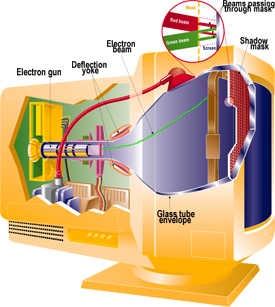Cathode Ray Tubes (CRTs)
|
|
|
CRTs, or video monitors, are the most common output device
on computers today.
The figure below illustrates the basic structure of a CRT.
A CRT is an evacuated glass tube, with a heating element
on one end and a phosphor coated screen on the other.
When a current flows through this heating element, called a filament, the conductivity
of the metal filament is reduced due to the high temperature. This cause electrons
to pile up on the filament, because they can not move as fast as they would
like to. Some of these electrons actually boil off of the filament.
These free electrons are attracted to a strong positive charge from the outer
surface of the focusing anode cylinder (sometimes called an electrostatic lens).
However, the inside of the cylinder has a weaker negative charge. Thus when
the electrons head toward the anode they are forced into a beam and accelerated
by the repulsion of the inner cylinder walls in just the way that water is speeds
up when its flow though a smaller diameter pipe. By the time the electrons get
out they're going so fast that they fly past the cathode they were heading for.
The next thing that the electrons run into are two sets of weakly charged deflection
plates. These plates have opposite charges, one positive the other negative.
While their charge is not strong enough to capture the fast moving electrons
they do influence the path of the beam. The first set displaces the beam up
and down, and the second displaces the beam left and right. The electrons are
sent flying out of the neck of the bottle, until they smash into the phosphor
coating on the other end of the bottle.
The impact of this collision on the out valence bands of the phosphor compounds
knocks some of the electrons to jump into the another band. This causes a few
photons to be generated, and results in our seeing a spot on the CRT's face.
